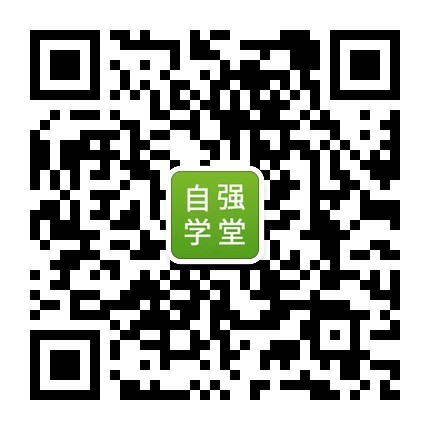Python/Django 微信接口
注册或登陆 微信公众平台 点击左侧的 开发者中心
填写相应的网址,Token(令牌) 是随便写的,你自己想写什么就写什么,微信验证时检验是否写的和服务器上的TOKEN一样,一样则通过。
关注一下自强学堂的微信号吧,可以随时随地查阅教程哦,体验一下自强学堂的微信的各种功能再阅读效果更佳!

自己动手写微信的验证: views.py
#coding=utf-8
import hashlib
import json
from lxml import etree
from django.utils.encoding import smart_str
from django.views.decorators.csrf import csrf_exempt
from django.http import HttpResponse
from auto_reply.views import auto_reply_main # 修改这里
WEIXIN_TOKEN = 'write-a-value'
@csrf_exempt
def weixin_main(request):
"""
所有的消息都会先进入这个函数进行处理,函数包含两个功能,
微信接入验证是GET方法,
微信正常的收发消息是用POST方法。
"""
if request.method == "GET":
signature = request.GET.get("signature", None)
timestamp = request.GET.get("timestamp", None)
nonce = request.GET.get("nonce", None)
echostr = request.GET.get("echostr", None)
token = WEIXIN_TOKEN
tmp_list = [token, timestamp, nonce]
tmp_list.sort()
tmp_str = "%s%s%s" % tuple(tmp_list)
tmp_str = hashlib.sha1(tmp_str).hexdigest()
if tmp_str == signature:
return HttpResponse(echostr)
else:
return HttpResponse("weixin index")
else:
xml_str = smart_str(request.body)
request_xml = etree.fromstring(xml_str)
response_xml = auto_reply_main(request_xml)# 修改这里
return HttpResponse(response_xml)auto_reply_main 是用来处理消息,回复消息的,需要自己进一步完善。使用第三方包实现:
关于Django开发微信,有已经做好的现在的包可以使用 wechat_sdk 这个包,使用文档 也比较完善,但是在处理加密一部分没有做,在微信公众平台上,需要用明文验证,如果要加密,自己参照微信官网的加密算法。
使用 wechat_sdk 的例子(自强学堂微信号简化后的例子):
# -*- coding: utf-8 -*-
from __future__ import unicode_literals
from django.http.response import HttpResponse, HttpResponseBadRequest
from django.views.decorators.csrf import csrf_exempt
from wechat_sdk import WechatBasic
from wechat_sdk.exceptions import ParseError
from wechat_sdk.messages import TextMessage
WECHAT_TOKEN = 'zqxt'
AppID = ''
AppSecret = ''
# 实例化 WechatBasic
wechat_instance = WechatBasic(
token=WECHAT_TOKEN,
appid=AppID,
appsecret=AppSecret
)
@csrf_exempt
def index(request):
if request.method == 'GET':
# 检验合法性
# 从 request 中提取基本信息 (signature, timestamp, nonce, xml)
signature = request.GET.get('signature')
timestamp = request.GET.get('timestamp')
nonce = request.GET.get('nonce')
if not wechat_instance.check_signature(
signature=signature, timestamp=timestamp, nonce=nonce):
return HttpResponseBadRequest('Verify Failed')
return HttpResponse(
request.GET.get('echostr', ''), content_type="text/plain")
# 解析本次请求的 XML 数据
try:
wechat_instance.parse_data(data=request.body)
except ParseError:
return HttpResponseBadRequest('Invalid XML Data')
# 获取解析好的微信请求信息
message = wechat_instance.get_message()
# 关注事件以及不匹配时的默认回复
response = wechat_instance.response_text(
content = (
'感谢您的关注!\n回复【功能】两个字查看支持的功能,还可以回复任意内容开始聊天'
'\n【<a href="https://www.zqxt.cn">自强学堂手机版</a>】'
))
if isinstance(message, TextMessage):
# 当前会话内容
content = message.content.strip()
if content == '功能':
reply_text = (
'目前支持的功能:\n1. 关键词后面加上【教程】两个字可以搜索教程,'
'比如回复 "Django 后台教程"\n'
'2. 回复任意词语,查天气,陪聊天,讲故事,无所不能!\n'
'还有更多功能正在开发中哦 ^_^\n'
'【<a href="https://www.zqxt.cn">自强学堂手机版</a>】'
)
elif content.endswith('教程'):
reply_text = '您要找的教程如下:'
response = wechat_instance.response_text(content=reply_text)
return HttpResponse(response, content_type="application/xml")下面是一个更详细复杂的使用例子:
models.py
# -*- coding: utf-8 -*-
from __future__ import unicode_literals
from django.db import models
class KeyWord(models.Model):
keyword = models.CharField(
'关键词', max_length=256, primary_key=True, help_text='用户发出的关键词')
content = models.TextField(
'内容', null=True, blank=True, help_text='回复给用户的内容')
pub_date = models.DateTimeField('发表时间', auto_now_add=True)
update_time = models.DateTimeField('更新时间', auto_now=True, null=True)
published = models.BooleanField('发布状态', default=True)
def __unicode__(self):
return self.keyword
class Meta:
verbose_name='关键词'
verbose_name_plural=verbose_nameviews.py
# -*- coding: utf-8 -*-
from __future__ import unicode_literals
from django.http.response import HttpResponse, HttpResponseBadRequest
from django.views.decorators.csrf import csrf_exempt
from wechat_sdk import WechatBasic
from wechat_sdk.exceptions import ParseError
from wechat_sdk.messages import (TextMessage, VoiceMessage, ImageMessage,
VideoMessage, LinkMessage, LocationMessage, EventMessage
)
from wechat_sdk.context.framework.django import DatabaseContextStore
from .models import KeyWord as KeyWordModel
# 实例化 WechatBasic
wechat_instance = WechatBasic(
token='zqxt',
appid='xx',
appsecret='xx'
)
@csrf_exempt
def index(request):
if request.method == 'GET':
# 检验合法性
# 从 request 中提取基本信息 (signature, timestamp, nonce, xml)
signature = request.GET.get('signature')
timestamp = request.GET.get('timestamp')
nonce = request.GET.get('nonce')
if not wechat_instance.check_signature(
signature=signature, timestamp=timestamp, nonce=nonce):
return HttpResponseBadRequest('Verify Failed')
return HttpResponse(
request.GET.get('echostr', ''), content_type="text/plain")
# POST
# 解析本次请求的 XML 数据
try:
wechat_instance.parse_data(data=request.body)
except ParseError:
return HttpResponseBadRequest('Invalid XML Data')
# 获取解析好的微信请求信息
message = wechat_instance.get_message()
# 利用本次请求中的用户OpenID来初始化上下文对话
context = DatabaseContextStore(openid=message.source)
response = None
if isinstance(message, TextMessage):
step = context.get('step', 1) # 当前对话次数,如果没有则返回 1
# last_text = context.get('last_text') # 上次对话内容
content = message.content.strip() # 当前会话内容
if message.content == '新闻':
response = wechat_instance.response_news([
{
'title': '自强学堂',
'picurl': '/static/images/newlogo.png',
'description': '自强学堂致力于提供优质的IT技术教程, 网页制作,服务器后台编写,以及编程语言,如HTML,JS,Bootstrap,Python,Django。同时也提供大量在线实例,通过实例,学习更容易,更轻松。',
'url': 'https://www.zqxt.cn',
}, {
'title': '百度',
'picurl': 'http://doraemonext.oss-cn-hangzhou.aliyuncs.com/test/wechat-test.jpg',
'url': 'http://www.baidu.com',
}, {
'title': 'Django 教程',
'picurl': '/media/uploads/images/django_logo_20140508_061519_35.jpg',
'url': 'https://www.zqxt.cn/django/django-tutorial.html',
}
])
return HttpResponse(response, content_type="application/xml")
else:
try:
keyword_object = KeyWordModel.objects.get(keyword=content)
reply_text = keyword_object.content
except KeyWordModel.DoesNotExist:
try:
reply_text = KeyWordModel.objects.get(keyword='提示').content
except KeyWordModel.DoesNotExist:
reply_text = ('/:P-(好委屈,数据库翻个遍也没找到你输的关键词!\n'
'试试下面这些关键词吧:\nKEYWORD_LIST\n'
'<a href="http://www.rxnfinder.org">RxnFinder</a>'
'感谢您的支持!/:rose'
)
# 将新的数据存入上下文对话中
context['step'] = step + 1
context['last_text'] = content
context.save() # 非常重要!请勿忘记!临时数据保存入数据库!
if 'KEYWORD_LIST' in reply_text:
keyword_objects = KeyWordModel.objects.exclude(keyword__in=[
'关注事件', '测试', 'test', '提示']).filter(published=True)
keywords = ('{}. {}'.format(str(i), k.keyword)
for i, k in enumerate(keyword_objects, 1))
reply_text = reply_text.replace(
'KEYWORD_LIST', '\n'.join(keywords))
# 文本消息结束
elif isinstance(message, VoiceMessage):
reply_text = '语音信息我听不懂/:P-(/:P-(/:P-('
elif isinstance(message, ImageMessage):
reply_text = '图片信息我也看不懂/:P-(/:P-(/:P-('
elif isinstance(message, VideoMessage):
reply_text = '视频我不会看/:P-('
elif isinstance(message, LinkMessage):
reply_text = '链接信息'
elif isinstance(message, LocationMessage):
reply_text = '地理位置信息'
elif isinstance(message, EventMessage): # 事件信息
if message.type == 'subscribe': # 关注事件(包括普通关注事件和扫描二维码造成的关注事件)
follow_event = KeyWordModel.objects.get(keyword='关注事件')
reply_text = follow_event.content
# 如果 key 和 ticket 均不为空,则是扫描二维码造成的关注事件
if message.key and message.ticket:
reply_text += '\n来源:扫描二维码关注'
else:
reply_text += '\n来源:搜索名称关注'
elif message.type == 'unsubscribe':
reply_text = '取消关注事件'
elif message.type == 'scan':
reply_text = '已关注用户扫描二维码!'
elif message.type == 'location':
reply_text = '上报地理位置'
elif message.type == 'click':
reply_text = '自定义菜单点击'
elif message.type == 'view':
reply_text = '自定义菜单跳转链接'
elif message.type == 'templatesendjobfinish':
reply_text = '模板消息'
response = wechat_instance.response_text(content=reply_text)
return HttpResponse(response, content_type="application/xml")